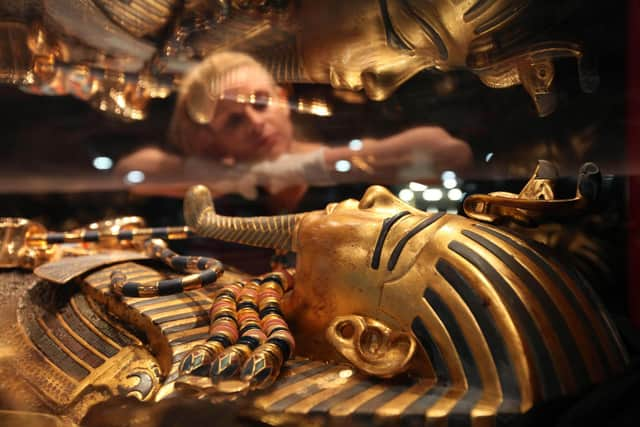Scenes of magnificence as tombs are revealed in the Valley of the Kings (1922)
and live on Freeview channel 276
It detailed: “This afternoon Lord Carnarvon and Mr Howard Carter revealed a large company what promises to be the most sensational Egyptological discovery the century. The find consists, among other objects, of the funeral paraphernalia of the Egyptian King Tut-ankh-Amen, one of the famous heretic kings of the Eighteenth Dynasty who Amun worship. Little is known of the later kings, including Tut-ankh-Amen, and the discovery should add invaluably to our knowledge of this period and the great city of Tel-el-Amarna, which was founded in the fifteenth century BC by Amenhotap IV, the first of the heretic kings.
“For nearly sixteen years Lord Carnarvon, with the assistance of Mr Howard Carter, has been carrying out excavations on that part the site of the ancient Thebes situated on the west bank of the Nile at Luxor. Seven years ago work was started in the Valley Kings after other excavators had abandoned the valley. The search was continued systematically, and at last the dogged perseverance Mr Carter, his thoroughness, and above all his flair, were rewarded by the discovery that the royal necropolis the Theban Empire was situated directly below the tomb of Rameses VI. Mr Carter covered up the site, and telegraphed to Lord Carnarvon, who at once came out from England.
Advertisement
Hide AdAdvertisement
Hide AdIt added: “Little, however, did Lord Carnarvon and Mr Carter suspect the wonderful nature of the contents of the chambers - for there are more than one - as they stood outside. The sealed outer door was carefully opened; then the way was cleared down some sixteen steps along a passage about 25 feet. The door to the chamber was found sealed, as on the outer door had been, and the outer door, there were traces of re-closing. With difficulty an entrance was effected, and when last the excavators managed to squeeze their way in, an extraordinary sight met their eyes - one that they could be scarcely credit.”


The reports continued: “First they sew three magnificent state coaches, all gilt, with exquisite carving. On these rested beds, beautifully carved and gilt, and inlaid with ivory and semi-precious stones, and also innumerable boxes of exquisite workmanship. One of these boxes was inlaid with ebony and ivory, with a gilt inscription. Another contained emblems of the underworld, a third - which contained the royal robes handsomely embroidered, precious stones, and golden sandals - were beautifully painted hunting scenes. There was a stool of ebony, inlaid with ivory, with the most delicately carved ducks’ feet; also a child stool of fine workmanship. Beneath one of the coaches was the state throne of King Tut-ankh-Amen - probably one of the most beautiful objects of art ever discovered. There was also a heavily-gilt chair, with portraits of the King and Queen, the whole encrusted with turquoise, cornelian, lapis, and other semi-precious stones.”
“Two life-sized statues of the King, holding stick and mace, faded each other. The features were handsome, the feet and hands delicately carved, while the eyes were of glass, and the bead-dress was richly studded with gems. There were also four chariots, the sides of which were encrusted with semi-precious stones and rich gold decoration. These were dismantled, with a charioteer's apron of leopard’s skin hanging over the seat. There were also enormous quantities of provisions for the dead, comprising trussed duck, haunches venison, &c, all packed in boxes, according to the custom of the time. There were some remarkable wreaths, still looking ever-green, and one of the boxes contained rolls of papyri, which are expected to render a mass of information.”